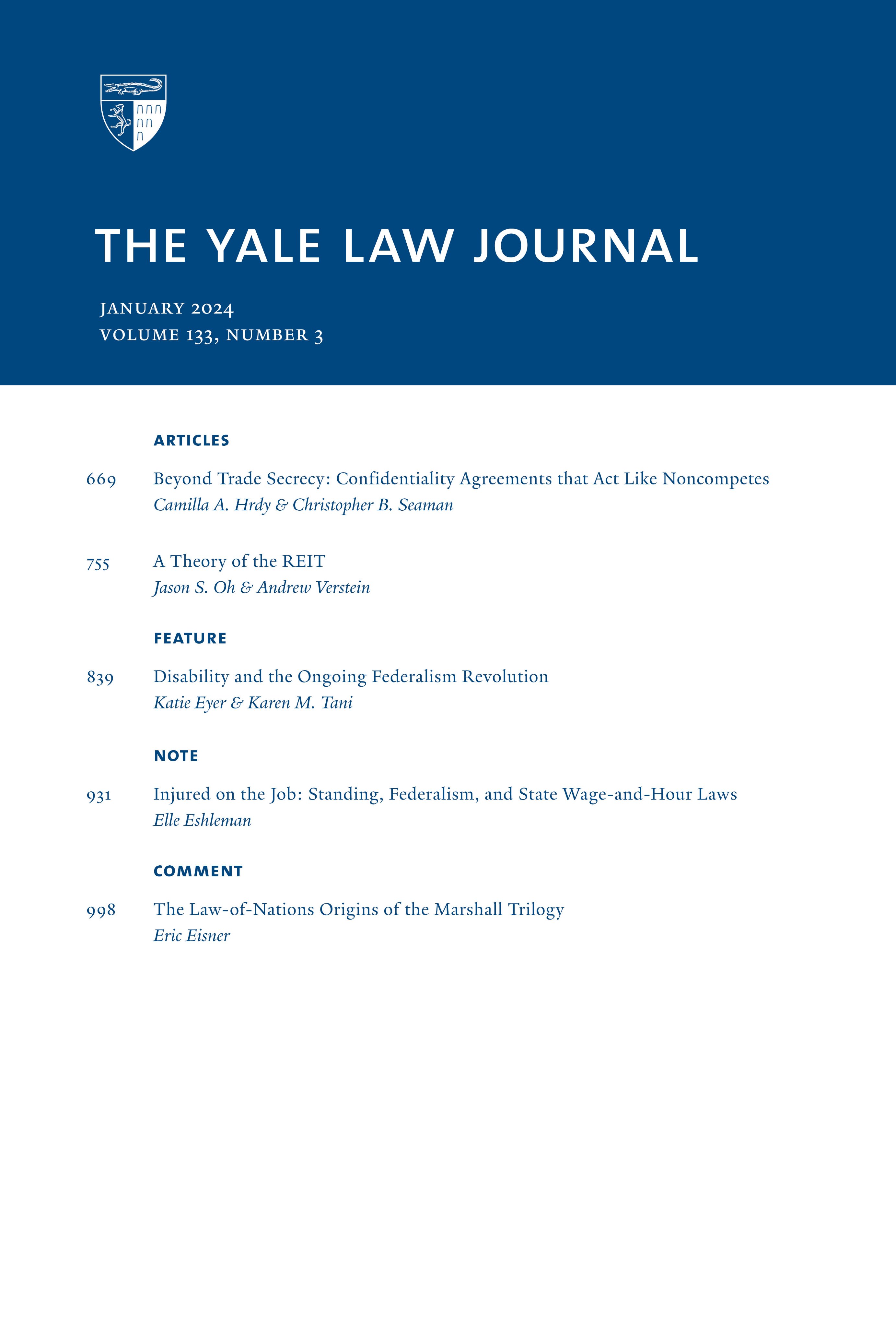行政决策审查中的规范性规范
IF 5.2
1区 社会学
Q1 LAW
引用次数: 5
摘要
谁应该确保法规的解释反映了国会未解决的背景规范——如尊重受监管方的权利、保护各州和美洲土著部落的利益、避免政府偏见和权力分立等规范?一方面,法院传统上试图通过应用规范的建筑规范来保护这些宪法启发的价值观。这样的解释性默认规则——比如解读成文法以避免引发宪法问题,避免先发制人地保护国家侵权行为,或者避免对部落权力产生不利影响——提供了一种司法手段,在考虑背景规范的情况下解决成文法的模糊性。另一方面,在最高法院对雪佛龙的裁决之后,解释不明确的监管法规的权力通常不属于法官,而是属于机构。这个问题使法院和评论员两极分化。包括最高法院在内的多数法院采取了一种明确的方式,即判例凌驾于雪佛龙之上,完全取代了该机构的解释性角色。包括第九巡回法院在内的少数人得出了相反的结论:法院不应该适用教规,而是将充分的解释性自由裁量权留给机构。本文拒绝这两种分类方法。第一种观点忽略了这样一个事实,即虽然规范性规范旨在促进解决政治问题时的司法克制,但它们往往赋予法官很大的自由裁量权,以决定重要的背景规范是否应该受到保护,以及做出与规范性规范本身无关的更广泛的公共政策选择。此外,行使这种自由裁量权往往涉及对这些选择的实际影响和一般行政政策的优点进行评估,而法官往往不适合作出这些评估。相比之下,少数人方法认识到,机构由于其政策专长、对政治力量的敏感性以及在决策过程中为代表和迁就提供论坛的能力,有时可能是协调政策目标与背景规范的最佳场所。然而,它没有为各机构提供从事这种行为的任何激励,也没有反映出行政能力何时能起作用,何时不起作用的任何辨别。从本质上讲,它构成了对规范保护责任的放弃。文章随后提出了另一种分析框架。它认为,一个机构的政策是否符合背景规范,应该作为雪佛龙逐案调查政策是否合理的第二步调查的一部分来考虑。与分类方法不同,这种对上下文敏感的解决方案首先为强有力的机构规范保护创造了激励,但也允许法院在行政决策要么没有提供什么优势,要么没有考虑到其隐含的背景价值时独立应用规范性规范。这一解决方案还赋予了司法自由裁量权,以解决更广泛的政策问题,并迫使法院更清楚地了解何时、为何适用不同的规范表述,以及对机构投入的影响。总之,它最好地利用了行政国家的能力,以促进对监管目标和宪法层面的规范之间的平衡进行负责任和知情的审议。本文章由计算机程序翻译,如有差异,请以英文原文为准。
Normative Canons in the Review of Administrative Policymaking
Who should ensure that statutes are interpreted to reflect background norms left unaddressed by Congress - norms like respect for the rights of regulated parties, protection of the interests of states and Native American tribes, avoidance of government bias, and the separation of powers? One the one hand, courts have traditionally sought to protect these constitutionally inspired values by applying normative canons of construction. Such interpretive default rules - like reading statutes so as not to raise constitutional issues, not to preempt state tort protections, or not to affect tribal power detrimentally - provide a judicial means for resolving statutory ambiguity with background norms in mind. One the other hand, after the Supreme Court's Chevron decision, authority to interpret unclear regulatory statutes generally belongs, not to judges, but to agencies. This question has polarized courts and commentators. A majority, including the Supreme Court, adopt a categorical approach in which canons trump Chevron, displacing the agency's interpretive role altogether. A minority, including the Ninth Circuit, conclude the opposite: that courts should not apply canons, but leave full interpretive discretion to agencies. This Article rejects both categorical approaches. The first ignores the fact that, while normative canons are intended to promote judicial restraint in resolving political questions, they often give judges great discretion in deciding whether or not important background norms should, or should not, be protected, and in making broader public policy choices unrelated to the normative canon itself. Exercising that discretion, moreover, frequently involves assessments regarding the practical impact of those choices, and about the merits of administrative policy generally, which judges are often ill-suited to make. The minority approach, by contrast, recognizes that agencies - because of their policy expertise, their sensitivity to political forces, and their ability to provide a forum for representation and accommodation in policymaking - may sometimes provide the best location for reconciling policy goals with background norms. Yet it fails to provide agencies with any incentive to engage in such behavior, or reflect any discernment regarding when administrative capacity could be helpful, and when it would not. It constitutes, essentially, an abdication of responsibility for norm protection. The Article then proposes an alternate analytic framework. It argues that whether an agency policy comports with background norms should be considered as part of Chevron's case-by-case step-two inquiry into whether the policy is reasonable. Unlike the categorical approaches, this context-sensitive solution creates incentives for robust agency norm-protection in the first instance, but also permits courts to apply normative canons independently when administrative decisionmaking either offers little advantage, or fails to account for the background values it implicates. This solution also cabins judicial discretion to resolve broader policy questions, and compels courts to be clearer about when, and why, different canonic formulations should apply, and the implications for agency input. In sum, it best enlists the capacity of the administrative state to promote accountable and informed deliberation on the balance between regulatory goals and norms of constitutional dimension.
求助全文
通过发布文献求助,成功后即可免费获取论文全文。
去求助
来源期刊

Yale Law Journal
LAW-
CiteScore
4.50
自引率
6.20%
发文量
0
期刊介绍:
The Yale Law Journal Online is the online companion to The Yale Law Journal. It replaces The Pocket Part, which was the first such companion to be published by a leading law review. YLJ Online will continue The Pocket Part"s mission of augmenting the scholarship printed in The Yale Law Journal by providing original Essays, legal commentaries, responses to articles printed in the Journal, podcast and iTunes University recordings of various pieces, and other works by both established and emerging academics and practitioners.
 求助内容:
求助内容: 应助结果提醒方式:
应助结果提醒方式:


